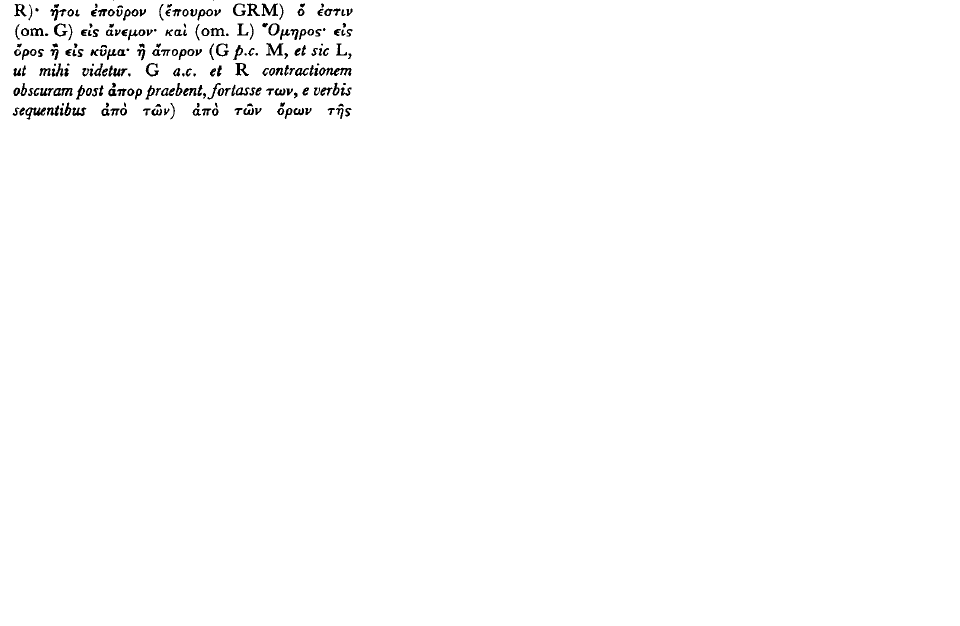Article contents
The Manuscript a of Sophocles and its Relation to the Moschopulean Recension
Published online by Cambridge University Press: 11 February 2009
Extract
Professor Kamerbeek in a recent article raises some interesting questions about the value of the manuscript of Sophocles Parisinus gr. 2712, universally known as A. Ever since the time of Brunck, who was the first to use this manuscript extensively, it has been considered second only to Laurentianus XXXII 9 (L) as a source of correct readings and as a witness of the old, i.e. pre-Byzantine, tradition of Sophocles. But the importance of A has been seriously challenged by Alexander Turyn, who has sought to show that in Ajax, Electra, and Oedipus Tyrannus—the three plays which constitute the Byzantine Triad of Sophocles—A's text is principally that of the recension of Manuel Moschopulus (fl. c. A.D. 1290)—or, more strictly, the version of that recension which includes scholia by Maximus Planudes and some slight variations in the poetic text.
- Type
- Research Article
- Information
- Copyright
- Copyright © The Classical Association 1960
References
page 51 note 1 Mnemosyne, S. IV, xi. 1 (1958), 25 ff.Google Scholar
page 51 note 2 For modern championship of A see Dain, A., Sophocle I. Les Trachiniennes, Antigone (ed. Budé, ), Introduction, pp. xliii ff.,Google Scholar ‘le Parisinus gr. 2712 est un manuscrit précieux par le choix important de leçons anciennes qu'il nous a conservées.’
page 51 note 3 ‘The Sophocles Recension of Manuel Moschopulus’ in Transactions and Proceedings of the American Philological Association, lxxx (1949) (pp. 139 ff. on A);Google Scholar and ‘Studies in the Manuscript Tradition of the Tragedies of Sophocles’, Illinois Studies in Language and Literature, xxxvi (1952) (pp. 173 ff. on A). I shall quote these two important works as ‘Recension’ and ‘Studies’.Google Scholar
page 51 note 4 ‘Recension’, pp. 125 and 144.
page 51 note 5 For examples of A's divergences from Moschopulus see ‘Recension’, p. 145.
page 51 note 6 But in Philoctetes, O.C., Trachiniae, Antigone Turyn argues that A's original stock is derived from the Laurentian and Roman families, with many Byzantine inter polations (‘Studies’, p. 177).
page 51 note 7 ‘Studies’, pp. 173 ff.
page 51 note 8 The date of A is an important and much discussed problem. If A is late-thirteenth century as Dain asserts (op. cit., p. xliii), there may be some difficulty in supposing it to derive from a manuscript (π) itself already affected by Moschopulus' recension of c. 1290. But Turyn thinks A is a product of the fourteenth century, and I find it difficult to see how one can date a manuscript of this period with extreme precision (i.e. to within a few years) if there is no other indication than the hand itself. Turyn has effectively replied to criticisms of his dating of A in ‘The Byzantine Manuscript Tradition of the Tragedies of Euripides’, Illinois Studies in Language and Literature, xliii (1957), 89,Google Scholar note 146, where he remarks: ‘I do not understand how anyone can ignore the fact that the Paris 2712 must be posterior to the Moschopulean edition of Sophocles if it contains [as it does] some Moschopulean scholia on the Sophoclean triad.’ On these scholia see Turyn, , Harvard Studies in Classical Philology, lxiii. 161.Google Scholar
page 52 note 1 ‘Recension’, p. 143.
page 52 note 1 I leave for another occasion a fuller discussion of this family. Professor Kamerbeek himself accepts the existence of ρ as a distinct ancient family: ‘Nunc tantum non constat eos nobis testes esse alterius rami memoriae mediaevalis iuxta L (et Λ) ex una stirpe enati.’ On the Roman family see Turyn, ‘Recension’ and ‘Studies’ and Vittorio De Marco, , ‘Sulla tradizione mano-scritta degli scolii sofoclei’ in Studi Italiani difilologia classica, N.s. xiii (1936), 3–44,Google Scholar and ‘De scholiis in Sophoclis tragoedias veteribus’, in Memorie della R. Accademia Nazionale dei Lincei, classe di scienze morali, storiche e filologiche, Anno CCCXXXIV (1937), serie VI, vol. vi, fasc. ii.Google Scholar
page 52 note 3 The text of Sophocles in the Suda (c. A.D. 1000) is heavily on the side of ρ.
page 53 note 1 ‘Recension’, p. 145. It is important to remember that Turyn nowhere suggests that A is exclusively Moschopulean.
page 54 note 1 They have the usual Moschopulean (Xa) and Moschopuleo-Planudean (Xr, Xs) scholia.
page 54 note 1 The identification was made by means of the scholia, see Turyn, ‘Recension’.
page 54 note 3 On the deteriores, divided into two families ø and  , basically affiliated to A and γ, see Turyn, , ‘Studies’, chapters ix, x, xi.Google Scholar
, basically affiliated to A and γ, see Turyn, , ‘Studies’, chapters ix, x, xi.Google Scholar
page 54 note 4 ‘Studies’, p. 143. I think it unlikely, however, that ‘Gγρ recorded the reading  from the deteriores’. It seems to me more probable that
from the deteriores’. It seems to me more probable that  was originally in the text (η to explain the o in lyrics), then
was originally in the text (η to explain the o in lyrics), then  was written out in full above
was written out in full above  in a later copy, and survived as a variant (hence Gγρ) after the corruption
in a later copy, and survived as a variant (hence Gγρ) after the corruption  had got into the text.
had got into the text.
page 54 note 5 ‘Studies’, p. 60.
page 55 note 1 ‘Studies’, p. 174.
page 55 note 2 Marcianus 468, Pearson's symbol Ven.
page 55 note 3 Laurentianus XXXII. 40.
page 55 note 4 Laurentianus. Conv. Soppr. 41.
page 55 note 5 Professor Kamerbeek rightly points out here that the typically minuscule cor ruption  for
for  tends to disprove Dain's otherwise doubtful theory that L was transliterated from an uncial manuscript.
tends to disprove Dain's otherwise doubtful theory that L was transliterated from an uncial manuscript.
page 55 note 6 As far as I can tell from the facsimile of L the μ appears to be a contemporary cor rection. Jebb and Dindorf both thought so.
page 55 note 7 ‘Recension’, pp. 140, 146.
page 56 note 1 It was conjectured by Porson on Euripides, Orestes 614.
page 56 note 2 So Dain, A., Sophocle II. Ajax–Oedipe Roi-Électre.Google Scholar
page 56 note 3 Turyn gives a few more examples of A's divergence from Moschopulus, but there, too, it is easy to trace the source of A's reading, e.g. O.T. 786  LGR Moschopulus Thomani nonnulli,
LGR Moschopulus Thomani nonnulli,  A Thomani cett. Triclinius.
A Thomani cett. Triclinius.
page 56 note 4 ‘Recension’, p. 144. An obvious example is Ajax 1000: ![]() LA,
LA,  GR Moschopulus (et A).
GR Moschopulus (et A).
page 58 note 1 Heidelberg Palat. gr. 40, a manuscript of the γ family in O.T. This is an interesting case. The manuscript evidence makes it clear that  was in the source of γ and ρ, possibly with some variant which L adopted to give
was in the source of γ and ρ, possibly with some variant which L adopted to give  or else so confusedly written as to lead to corruption. The Scholion certainly seems to refer to something like
or else so confusedly written as to lead to corruption. The Scholion certainly seems to refer to something like 

page 58 note 1 On this reading see Turyn, , ‘Studies’, p. 124.Google Scholar
page 58 note 3 ‘Studies’, p. 45.
page 59 note 1 Here is the text of the scholion in LGRM: 


page 59 note 2 More interesting is R's divergence from L and G. R does very occasionally depart rom the ancient tradition and embrace a Byzantine reading. It is not, however, impossible that  was an ancient variant, in ipite of there being no trace of it in L and G.
was an ancient variant, in ipite of there being no trace of it in L and G.
page 60 note 1 e.g. Jebb, , ad loc.Google Scholar
page 60 note 1 ‘Recension’, p. 137.
page 60 note 1 Scheltema, H. J., ‘De Codice Sophocleo Lugdunensi’, Mnemosyne, S. IV, ii (1949), 132–7.CrossRefGoogle Scholar
page 60 note 4 ‘Recension’, p. 134.
page 61 note 1 ‘Studies’, p. 22.
page 61 note 2  may have got into the text as the result of a dittography:
may have got into the text as the result of a dittography:  , changed to
, changed to  which is very similar in minuscule. Or possibly the apostrophe in
which is very similar in minuscule. Or possibly the apostrophe in  was misread as the contraction for ov. Then
was misread as the contraction for ov. Then 
 would have been added above
would have been added above  as an apparently more correct alternative in view of the singular
as an apparently more correct alternative in view of the singular  .
.
page 62 note 1 Editors since the time of Dindorf have usually favoured  as the original reading, but
as the original reading, but  (read by Brunck and Dain) is very attractive, as it so easily accounts for the change to
(read by Brunck and Dain) is very attractive, as it so easily accounts for the change to  . Denniston, (The Greek Particles, 2nd ed., p. 509) recognizes the usage
. Denniston, (The Greek Particles, 2nd ed., p. 509) recognizes the usage  in tragedy.Google Scholar
in tragedy.Google Scholar
page 62 note 2 For examples of variants known to scholia see, for example, O.T. 194 quoted above. On the date and composition of the ancient scholia see de Marco, Vittorio, Scholia in Sophoclis Oedipum Coloneum (1952).Google Scholar
page 62 note 3 ‘Studies’, pp. 22–23.
page 62 note 4 ‘Studies’, p. 24.
page 63 note 1  being at the beginning of a line, the first letter might be obscured by scholia and omitted. It would not be difficult, either, to write
being at the beginning of a line, the first letter might be obscured by scholia and omitted. It would not be difficult, either, to write  by a sort of haplography.
by a sort of haplography.
page 63 note 1 Or there may be some connexion between  s.l. in AU and
s.l. in AU and  s.l. in Xr.
s.l. in Xr.
page 63 note 3 e.g. ‘Recension’, pp. 131 ff. Cf. Turyn, A., ‘The Byzantine Manuscript Tradition of the Tragedies of Euripides’, Illinois Studies in Language and Literature, xliii (1957) 117 ff.Google Scholar
page 63 note 4 The situation is very probably identical in Ajax and Electra, as Turyn's evidence suggests.
page 64 note 1 The true answer may be a compromise between the two extremes, namely that Moschopulus was indeed an able editor, but that he also had access to a fuller tradition of Sophocles than that available to us. This would not necessitate belief in a third ancient family, which would bring many attendant difficulties, and it would account for the more curious agreements with the papyri by supposing Moschopulus to have mown a greater range of variants and cholia and also of lexicographical works han is now extant.
page 64 note 2 I am very grateful to Professor D. L. Page or much illuminating criticism and advice, ind to Mr. R. D. Dawe for kindly reading his article in its final draft.
- 1
- Cited by




